Until recently, few people were aware that the berries of autumn olive, Elaeagnus umbellata, are edible. But the secret is out. More and more are harvesting these tasty fruits for both sweet and savory dishes. In addition to great flavor, there are several possible reasons for its growing popularity amongst foragers:
- The fruits are known to be rich in vitamins A, C, and E, flavonoides, and lycopene (Ahmad, et al., 2005, Acta Botanica Croatic, Vol. 64, No. 1, 2005).
- Its new name, “autumnberry”, sounds more palatable than autumn olive.
- The shrub is easy to find because it abounds where people abound. It thrives in suburbia, including the edge of my property. Perhaps it is around your yard, too.
- The easy to harvest berries are produced in great abundance.
- It is an invasive shrub (native to Asia), and environmentally conscious people realize that using the berries for sauces, fruit leather, and jam requires boiling the berries, killing the seeds.
That last point deserves emphasis. Killing the seeds of an invasive shrub reduces its spread. And that method of invasive species control -cooking – is much more adaptive than, say, dousing the plant with herbicides. Eating this plant is a way of going with the flow of nature, learning to adapt to environmental change, rather than waging chemical warfare against it.
Elaeagnus umbellata was introduced from Asia and deliberately planted on sandy slopes along roadsides and bridge abutments, where it does an excellent job controlling erosion. Because birds relish the berries, autumn olive was also recommended as a great shrub for attracting birds. But its attractiveness to birds means that birds contribute to its spread, every time they deposit the seed in their droppings. Perhaps it’s ironic that those very characteristics which in the past made autumn olive “useful” – tolerance, vigor, and wildlife appeal – are the same ones that more recently earned it “pest” status.
And, it appears that our ambivalent relationship with this plant continues to evolve. There is yet another reason to see autumn olive’s vigor, catholic growth requirements, and tremendous productivity as beneficial. Some scientists think it might be a commercially viable cash crop, and fancy selection for genotypes for superior fruit production (Black et al., 2005. Journal of the American Pomological Society 59(3): 125-134).
So, is Elaeagnus umbellata a useful plant to be harvested, or a noxious weed to be poisoned? The choice is ours.
General description of autumn olive
Elaeagnus umbellata usually grows as a shrub with a widely spreading crown. It can reach 12-15 feet in height. Before it was labeled a noxious weed, autumn olive was often described as “fragrant” in flower, and as “stunning” in fall, with its bright red berries against its silvery foliage. Now the flowers are “cloying” and its growth habit “unruly”. Recently I heard the nickname “Ugly Agnes” for this Elaeagnus shrub. That’s human nature for you.
Autumn olive leaves, twigs, and spines
The 1-4 inch long elliptical to ovate or oblong leaves have smooth edges. They are rich green above, with silvery undersides, and arranged alternately along brown twigs.
The alternate arrange of the leaves is a very important identification clue. This is because some honeysuckle shrubs also have small oval leaves, red berries, and yellow trumpet-like flowers (see photo of flowers, below). Some honeysuckles bear toxic berries, but all of them feature oppositely arranged leaves. So before you eat the berries, confirm that you’ve got an autumn olive by confirming that the leaves are alternate.
Sometimes there are spines on autumn olive twigs. Some specimens seem to have many spines, some have a few, and perhaps some have none at all. But I’ve found that if I look hard enough, all autumn olive shrubs have at least a few. I don’t know why this is so variable. But do look out for spines when you harvest berries, because they are sturdy, sharp, and hazardous to probing fingers.
Flowers of Elaeagnus umbellata
The very fragrant creamy to yellow, trumpet-like, tubular blossoms appear in May. As I said above, some honeysuckles have similar flowers. And, as stated above, it’s important to get it right if you want to eat the berries, because some species of honeysuckle bear poisonous berries. Again, be sure you have autumn olive by confirming the alternate arrangement of the leaves (see above).
Autumn olive berries
Or “autumnberries” for short. When ripe, they are bright, deep red, speckled with tiny silvery dots. Each berry contains a single pit that is almost small enough to be swallowed comfortably…But not quite.
Berries ripen as early as late August in full sun, but those in part shade ripen as late as the end of September. The flavor is sweet-tart and they sweeten somewhat over time, but the birds get a lot of them if you wait for that.
Sometimes the berries are borne in such abundance that branches sag under the weight. Occasionally an entire shrub will topple under the weight.
Where to forage for autumn olive
Native to Asia, Elaeagnus umbellata now enjoys life in Ontario and most of the eastern US, as well as some mid-western and northwestern states. If you’re the visual type, have a look at its range map. The bad thing about this plant is that it can be found almost anywhere within its current range….if you hate it as a noxious invasive plant. The good thing about this plant is that it can be found almost anywhere within its current range….if you’re after the delicious berries.
Autumn olive is tolerant of a wide range of soils, from sands to clays, from acid to alkaline. It likes good drainage and tolerates drought. It tolerates part shade but fruit production is best in full sun. So, for ease of harvesting, look for autumn olive in edge habitat, especially in areas with a lot of human disturbance, which often sets the stage for colonization by opportunistic plants such as this one. Field edges and road sides are prime locations.
How to harvest autumnberries
I’ve found that the quickest way harvest these berries is to run the fingers of one hand along berry laden twigs, allowing the berries to fall into a basket I hold with the other hand. In this way you can collect a large quantity within a very short time, but you will also have a lot of leaf and twig debris to pick out later. Even so, it’s much faster than carefully and cleanly picking off one berry at a time.
I harvest them as soon as they turn red, but most people prefer to wait a few weeks for them to sweeten. Everyone’s different: When other people think they’re finally sweet enough, I think they taste a bit rotten. I prefer the mouth puckering tartness of just-ripened berries.
Preparing and eating autumnberries
These juicy, sweet-tart berries would be wonderful to eat by the handful, were it not for the pit that’s just large enough to be annoying. I don’t eat too many of them raw, but when I do, I usually swallow the pits. I sprinkle a few in my yogurt and use them as a garnish, but cooking them greatly expands the possibilities. Boiling, mashing, and running the berries through a food mill removes the pits from the delicious pulp which can be used for sauces, jams, and fruit leather. Here is my recipe for autumn olive berry jam. The flavor lends itself well to both sweet and savory dishes. In my recipe for autumnberry ice cream pie, I layer a nutty graham cracker crust with autumnberry sauce, covered with a liqueur spiked mascarpone ice cream.
Shared on:











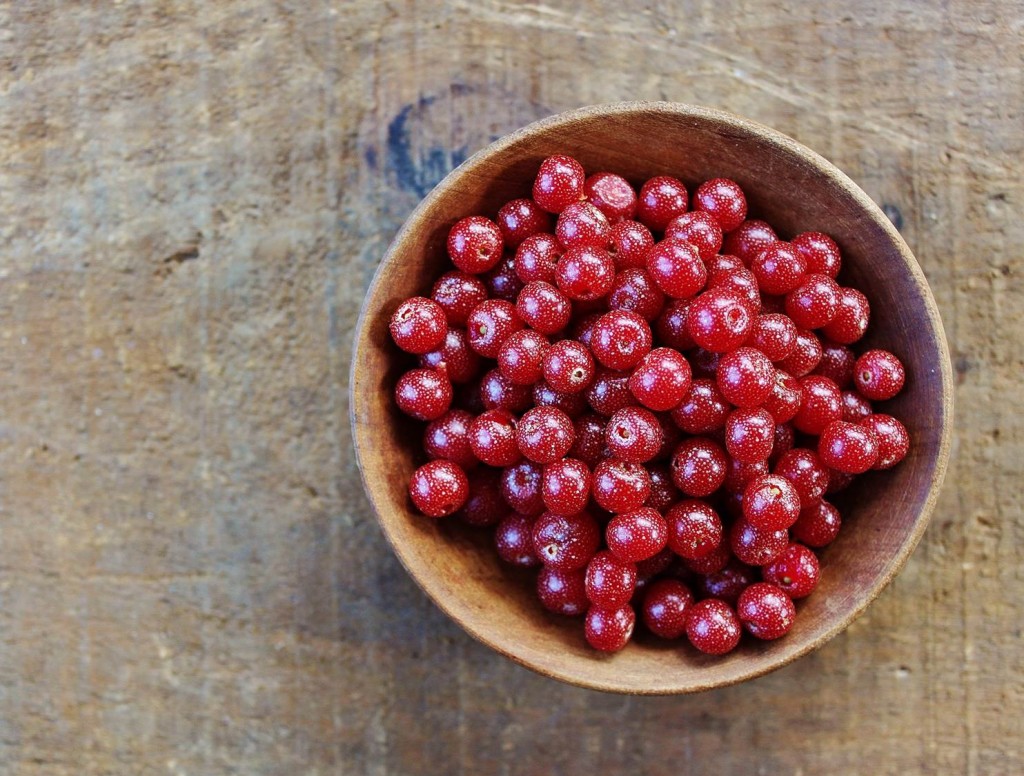
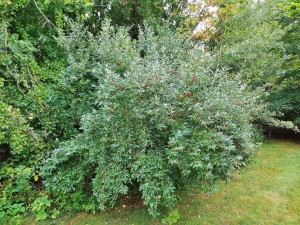
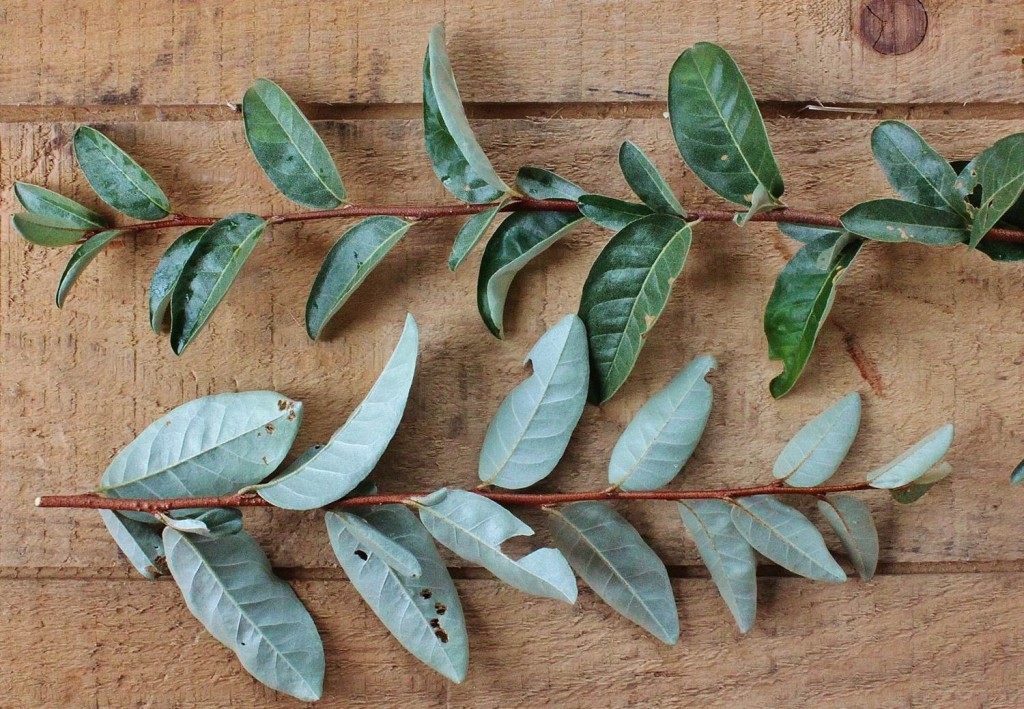
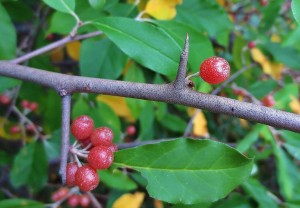

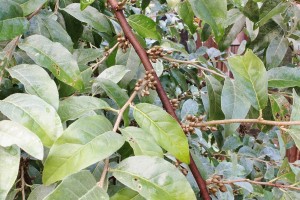
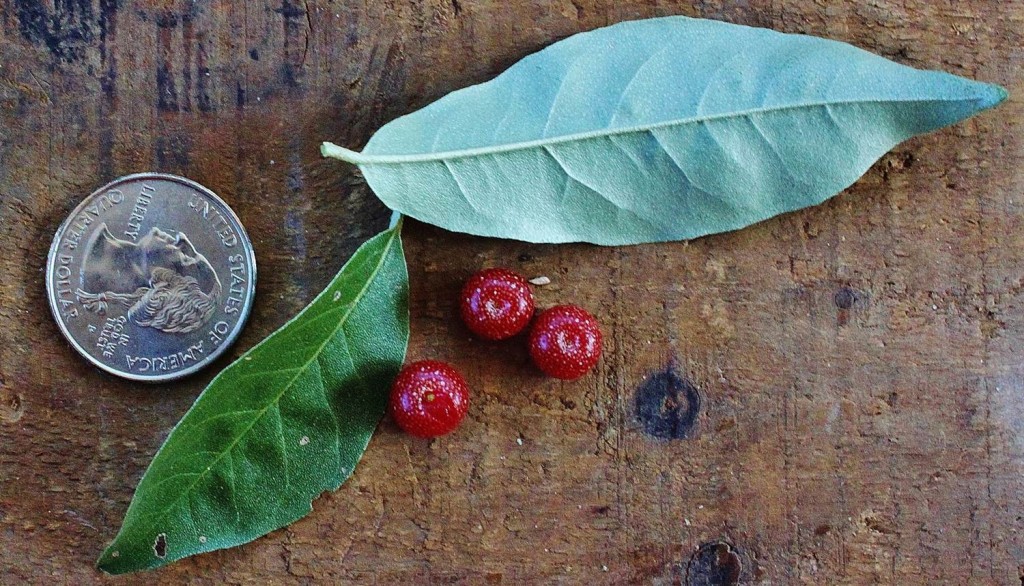
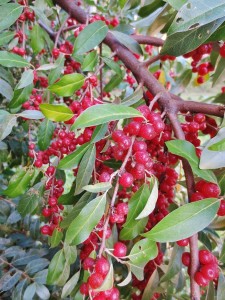
Your photos perfectly complement your text. You have done justice to a wonderfully tasty wild food!
I agree with Josh. I’m a big fan of these very versatile berries. After the boiling/mashing/straining process, I’ve tried leaving the leftover seeds on a stone wall. The chipmunks have proven to be very receptive. My assumption is that they store the seeds en masse in their middens for later consumption. I don’t want to take the rap for spreading invasives, not matter how delectable!
Pingback: Autumnberry ice cream pie with hazelnuts - One Acre Farm
Thanks. And Josh, you have some nice photos of this plant, too. It’s a great one to eat, so it’s good to get the word out. Susan, I would not worry about spreading the seeds left over from the cooking process. I checked with a botanist and wild edibles expert, and was told that boiling definitely kills the seeds. So it’s okay to leave them out for chipmunks or dump them into your compost.
By the way, I just posted a recipe using these berries, if you’re interested: https://ouroneacrefarm.com/autumnberry-ice-cream-pie/
Pingback: Foraging Ethic - One Acre Farm
Pingback: Creating a Chicken Habitat with Tips from Jungle Fowl - One Acre Farm
This is a great resource! I love using invasives for food and medicine rather than using warfare on them.
Thanks, Christine, that is exactly my philosophy. Glad you enjoyed the post!
Another plant for me to be on the lookout for. Your posts are so informative, thank you!
Glad you find them useful, Rachel!
Hi, is it too soon to pick autumn berries? I’ve found a few trees and tasted the berries. They seemed pretty good, but maybe they are better later? Though I don’t want to wait too long and find them all gone. Thanks!
Hi Kim, it depends. Here in MA, some bushes have berries ripe enough for my taste buds, while on other bushes the berries are still green. But even after turning red, they’re not palatable to some people until after a frost. I like them tart, so I’m picking some this weekend.
Pingback: Autumn Olive Jam and Why You Should Make It - One Acre Farm
One thing not mentioned when helping identify is the fact that there are white dots the size pin heads on the berries.
In the 1st paragraph describing the berries, it does say that they are speckled with tiny silvery dots.
are autumn olive bush and Russian olive the same thing?
Nope, but they are closely related. Russian olive is Elaeagnus angustifolia. Google it and compare photos of leaves and berries of the two species.
is it possible to buy the bushes, or plain berries?
I don’t know if it’s possible, but I hope not. It’s a non-native invasive plant in the US. If you want to buy autumn olive berry jam, google “autumn berry inspired”.
Pingback: Autumn Olive Fruit Leather - One Acre Farm
Are the leaves useful as a green or nitrogen in a compost pile. I have a shredder and a ton of these bushes
Hi Amy, I don’t know why they wouldn’t be useful as a source of nitrogen in compost.
Pingback: 4 Berry-Producing Shrubs that Fertilize, Too! | Tenth Acre Farm
Great article, I’ve got a lot of trees in my area, and am looking forward to harvest time.
Can the leaves be used as a tea?
Pingback: Elaeagnus umbellata – Herbal Ramble
Pingback: Silvery Russian Autumn | Flowers, Plants n Blooms
My siblings and I, and other kids in our western North Carolina neighborhood, were eating these berries as long ago as the 1950s. We had no idea what the correct name was and mistakenly called them “cranberries.” Older members of the family still call them that to this day. One of my nearby nieces told me today that she has been caring for one of the plants in a pot on her back patio, and getting berries from it, for the last two years. It was a delight to discover the real name and to read this excellent article about them.
Excellent article. I discovered autumn berries a few years ago on a hike and once I learned what they were I went back to forage some berries. I’ve been making delicious autumn berry jam every year since then. Your article was a big help in identification and an inspiration to jam up those berries. My friends and I thank you! (Yes, I share my jam ❤️)
I too was introduced to Autumn Olives about five years ago in Kentucky. The government would make the coal companies plant them on strip jobs after reclamation. Used to stop erosion and be a wildlife habitat at the same time for deer, Turkey’s, bear, birds etc. I was raised on Mayhaw and Possum grape jelly, but after eating Autumn Olive jelly there is no comparison. They do get sweeter after a frost. We would take plastic or blankets and lay on the ground under the tree and shake the branches. You can get a quick harvest this way.
My land suddenly within this past year now has a lot of autumn olives on it. I have other very invasive plants like privet and Callery Pears, Autumn Olive is the least aggressive of the 3, for now. So I think I’ll harvest the berries and try some stuff. Can you squeeze Autumn olive oil from them I wonder?
Hi where csn i buy the seeds ? Amazon has them but it says not available in my area
Resist the urge to plant them!! They are extremely invasive. Do yourself a favor and find someone who has them already. I would share berries with everyone! I do enjoy the jam which I add cinnamon and an apple to add a little pectin. We are fighting them back constantly. They are taking over our whole 11 acres and the 80 behind us.
Barbara, where do you live? What zone is it?
A great way to control Autumn Olive is to plant Walnut trees among them. The nitrogen fixed by the Olives allows Walnuts to grow and sunlight competition prevents side-branching resulting in high quality timber. Eventually the Walnuts shade-out and kill the Olives with Juglan, a toxin from the Walnuts’ roots.
Please do not plant these. These plants take the place of native plants that provide birds with appropriate nourishment. Non native species do not provide native insects, birds, animals with the exact nutrition they require and that eventually adds to the deterioration of their health, individually and as a species.
Invasive species can alter the chemistry of the soil and prevent native species from growing where they are needed. Please make an effort to learn about the true warfare, that of invasive species and native species. Growing these is the precise opposite of caring about the the natural world. Read Douglas Tallamy, Bringing Nature Home and others. Just because something looks good on the surface doesn’t mean it won’t create massive problems down the line.
Hello there!:
My name is Mariafernanda, I am a young scientist performing some research involving Palownia tomentosa and Elaeugnus umbellata. While searching where to buy 2.5 kg of its seeds I found your page. I want to ask you if you would please collect 2.5 kg of autumn olive seeds for me, for a price of course. Could you please inform me of the price and availability of such seeds? I must have them by no later than December the 20th, please respond at your earliest convenience.
Thank you so much!
Thanks, I came to your site looking for the name of this berry, so I know what to put on the bottles of wine I made from it. I am glad you told me to use Autumnberry instead of Autumn Olive.
Pingback: Podcast 63 5 Rules for Foraging Wild Edibles + 25 Wild Edible Plants – Melissa K. Norris
Great article. I,ve been making jam with them for over 20 yrs.. Sometimes I go half and half with a black raspberry puree.
Pingback: Autumn Olive: Is It A Preppers Friend, Frenemy Or A Plant To Kill On Sight? – Beans, Bullets, Bandages & You
I was wondering, does anyone know if you can eat the flowers?
This is our first Spring living in a house in rural central MA, on nearly three acres of sloped hillside. We recently discovered our property is overrun with Autumn Olive. The meadow in front of our house looks like an Autumn Olive orchard. They grow fast!!! We have spent the last week trying to tame the beast by cutting them back and now have repetitive stress injuries to show for our efforts.
I so appreciate your fresh perspective. Apparently the “Autumn Berries” love it here; can we learn to love the gifts they freely offer?
Hello! Good to find this post! I harvest in Western MA from very mature shrubs that grow around a man-made sand pit. I processed the berries raw and cooked. I get pulp by separating seeds and little stems in my Norwalk Juicer that grinds all berries but leaves the dry parts behind in the chute, like a “cork”. The pulp is almost 10% fruit only. I made varieties of flavored fruit lather, popsicles, experimented with salad dressings, froze pulp and sauces and canned sauces in jars. I could harvest hundreds of pounds just from one location. Flavors vary from bush to bush, and does not even depend on amunt of sun exposure, but perhaps soil just beneath the bushes, which are up to 15 feet high. These berries are a God-sent! I feel envigorated by them and have no colds or flu through the winter. However, I speculate that the seeds contain arsenic. Before I separated all seeds, the arsenic seemed to cause me hair loss. Be aware of increased urinary and gastic elimination if eaten in large amounts – as I did in the first year I encountered the berries.
Nice article. I am a fan of your philosophy, and I’ll be looking for these here in Idaho!
Cheers!
We recently discovered the autumn olive. Love the name Autumnberry as my name is Autumn! We could harvest a TON from or property alone. I read on a forging blog that the seeds contain healthy fats for the brain and also that autumn olive contain powerful antioxidant sputtering prostate health. Are you aware of any studies showing all the health benefits of the berry and seed?
Thanks for the good info. For many years my parents told me that these berries were poisonous because they were red. They had no idea they were edible. But I read some where that they make the most delicious juice. Jam sounds really good.
Please, PLEASE do not encourage people to harvest or propagate this plant! Its is an incredibly invasive non-native scourge that reproduces even faster than kudzu. Any part of the plant that touched the ground will sprout and grow. Birds eat the seeds and spread them however far they can fly. Once introduced in an area it will quickly spread and choke out all native vegetation other than trees and keep new trees from growing due to shading out the seedlings. If there was ever a plant worthy of chemical warfare this is it. If you have it, do whatever you have to do to eliminate it. And please do some research before you post an article like this.
No, it does not necessarily choke out all native vegetation and keep new trees from growing. That is an exaggeration that has been parroted on many websites. I have watched it grow in patches of abandoned farmland for over 20 years now. Autumn olive colonized these areas and did well initially, but over time, other plants, both native and non-native, have been choking it out. Now, mixed forest (mostly native trees) dominates these areas, having shaded out the autumn olive. I don’t harvest autumn olive berries anymore because the plant is almost gone from these places, having been replaced by forest.
So you choose to use chemical warfare on this plant, I see. And I suppose that like most people you also consume berries from chemically maintained domesticated plants. How environmentally destructive. I think it’s better to eat berries from plants that thrive without fertilizers and pesticides, especially when the process involves killing the seeds of an invasive plant, as is the case when one makes preserves, fruit leather, and syrup with autumn olive. But to each his or her own.
Pingback: Autumn-olive Fruit – How to ID and Enjoy | Curious By Nature
Pingback: Autumn Olive | Blue-Footed Musings